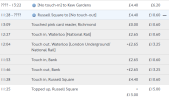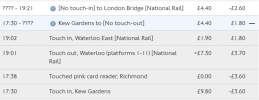Hello all,
I recently went on a trip down south to London with some friends and we got Oyster cards at Russell Sq and applied the 16-25 railcard to them - thinking this would be the cheapest way to travel around London when we know for sure that we will hit the daily cap. We also assumed tapping out of stations would end a trip and not contribute to the maximum journey time. I put the trip details down below.
I understand that for the Russell Square to Kew Gardens (if this is considered one trip, even with a break of 20 minutes at Waterloo to eat) this exceeded the 110 minutes (1h50m) journey time. Also the return combined exceeded the 110 minutes journey time by a mere minute. My questions are:
1. Is what is displayed because of exceeding the maximum journey time?
2. How come the 20 minute break at Waterloo was not enough to break the trip into two parts? How long do I have to wait before it counts are two seperate trips?
3. Is there a cheaper way to travel around via strange routes that doesn't break the bank when the maximum trip time is exceeded?
I have phoned up TfL who didn't provide anything more than "trust the system, it is right" to my questions.
______
We went from Russell Sq to Kew Gardens by taking the Piccadilly Line from Russell Sq to Holborn, Central Line to Bank, Waterloo & City Line to Waterloo. We had a short break (20 minutes) to get some food at Waterloo. Finally we took SWR from Waterloo to Richmond and Overground to Kew Gardens.

On return we went District Line from Kew Gardens to Richmond, SWR from Richmond to Waterloo (the long way round via Strawberry Hill for a scenic tour) and Southeastern from Waterloo East to London Bridge.

All in all ended up being a very expensive day out:

I recently went on a trip down south to London with some friends and we got Oyster cards at Russell Sq and applied the 16-25 railcard to them - thinking this would be the cheapest way to travel around London when we know for sure that we will hit the daily cap. We also assumed tapping out of stations would end a trip and not contribute to the maximum journey time. I put the trip details down below.
I understand that for the Russell Square to Kew Gardens (if this is considered one trip, even with a break of 20 minutes at Waterloo to eat) this exceeded the 110 minutes (1h50m) journey time. Also the return combined exceeded the 110 minutes journey time by a mere minute. My questions are:
1. Is what is displayed because of exceeding the maximum journey time?
2. How come the 20 minute break at Waterloo was not enough to break the trip into two parts? How long do I have to wait before it counts are two seperate trips?
3. Is there a cheaper way to travel around via strange routes that doesn't break the bank when the maximum trip time is exceeded?
I have phoned up TfL who didn't provide anything more than "trust the system, it is right" to my questions.
______
We went from Russell Sq to Kew Gardens by taking the Piccadilly Line from Russell Sq to Holborn, Central Line to Bank, Waterloo & City Line to Waterloo. We had a short break (20 minutes) to get some food at Waterloo. Finally we took SWR from Waterloo to Richmond and Overground to Kew Gardens.

On return we went District Line from Kew Gardens to Richmond, SWR from Richmond to Waterloo (the long way round via Strawberry Hill for a scenic tour) and Southeastern from Waterloo East to London Bridge.

All in all ended up being a very expensive day out:

